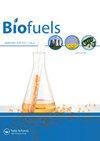在户外自然阳光下,在平板光生物反应器中调节宏量和微量营养素以提高Scenedesmus abundans的脂质生产
IF 2.6
4区 工程技术
Q3 ENERGY & FUELS
引用次数: 1
摘要
摘要本研究探讨了宏量和微量营养元素对富景菜光自养脂质生成的影响。利用常量营养素的一次变化和微量营养素相互作用的研究,制定了一种优化的脂质培养基。利用优化后的脂质培养基,在中等规模光生物反应器(PBRs)中采用单段和两段策略同时生产脂质和胞外多糖(EPS)。在单阶段培养中,脂肪酸甲酯(FAME,生物柴油)达到32%,而在两阶段PBR中仅观察到12.6%的FAME。采用单级策略,FAME效价为1.16 g/L,总FAME产率为32 mg/L/天,EPS为280 mg/L。此外,在白天自然光照和室外条件下,在2 L中型平板反应器中,采用单阶段策略,FAME含量为46%,FAME产量为1.28 g/L, FAME产量为27 mg/L/天,EPS为155 mg/L。除了高生物柴油和EPS产量外,该微藻菌株还具有高效的自然自絮凝能力。该菌株在无光抑制的户外培养条件下具有较高的脂质含量。微量营养素对黄鳝脂质积累有影响。在自然光照下,Scenedesmus丰度产生高生物柴油含量(DCW的46%)。该候选物可同时合成多种产物,为生物精制铺平了道路。本文章由计算机程序翻译,如有差异,请以英文原文为准。
Modulation of macro and micronutrients to enhance lipid production by Scenedesmus abundans in a flat-panel photobioreactor under outdoor natural sunlight
Abstract The present study investigates the effect of macro- and micronutrients on photoautotrophic lipid production from Scenedesmus abundans. An optimized lipid medium has been formulated using one-at-a-time variation of macronutrients and a study of micronutrient interactions. Both single-stage and two-stage strategies were used for simultaneous production of lipid and exopolysaccharide (EPS) in medium-scale photobioreactors (PBRs) using the optimized lipid medium. In the single-stage cultivation 32% fatty acid methyl ester (FAME, biodiesel) was achieved, whereas only 12.6% FAME was observed in two-stage PBR. A FAME titer of 1.16 g/L with overall FAME productivity of 32 mg/L/day and 280 mg/L EPS was achieved using the single-stage strategy. Further, under diurnal natural sunlight and outdoor conditions, a FAME content of 46%, with 1.28 g/L of FAME and 27 mg/L/day FAME productivity, and 155 mg/L EPS were achieved using the single-stage strategy in 2 L medium-scale flat-panel PBRs. Apart from high biodiesel and EPS production, this microalgal strain also has the ability to carry out natural autoflocculation with high efficiency. The strain could be exploited for high lipid content under outdoor cultivation without photoinhibition. Highlights Micronutrients have effects on lipid accumulation in Scenedesmus abundans. Scenedesmus abundans produced high biodiesel content (46% of DCW) under natural sunlight. Simultaneous synthesis of multiproducts by this candidate paves the way for biorefining.
求助全文
通过发布文献求助,成功后即可免费获取论文全文。
去求助
来源期刊

Biofuels-Uk
Energy-Renewable Energy, Sustainability and the Environment
CiteScore
5.40
自引率
9.50%
发文量
56
期刊介绍:
Current energy systems need a vast transformation to meet the key demands of the 21st century: reduced environmental impact, economic viability and efficiency. An essential part of this energy revolution is bioenergy.
The movement towards widespread implementation of first generation biofuels is still in its infancy, requiring continued evaluation and improvement to be fully realised. Problems with current bioenergy strategies, for example competition over land use for food crops, do not yet have satisfactory solutions. The second generation of biofuels, based around cellulosic ethanol, are now in development and are opening up new possibilities for future energy generation. Recent advances in genetics have pioneered research into designer fuels and sources such as algae have been revealed as untapped bioenergy resources.
As global energy requirements change and grow, it is crucial that all aspects of the bioenergy production process are streamlined and improved, from the design of more efficient biorefineries to research into biohydrogen as an energy carrier. Current energy infrastructures need to be adapted and changed to fulfil the promises of biomass for power generation.
Biofuels provides a forum for all stakeholders in the bioenergy sector, featuring review articles, original research, commentaries, news, research and development spotlights, interviews with key opinion leaders and much more, with a view to establishing an international community of bioenergy communication.
As biofuel research continues at an unprecedented rate, the development of new feedstocks and improvements in bioenergy production processes provide the key to the transformation of biomass into a global energy resource. With the twin threats of climate change and depleted fossil fuel reserves looming, it is vitally important that research communities are mobilized to fully realize the potential of bioenergy.
 求助内容:
求助内容: 应助结果提醒方式:
应助结果提醒方式:


